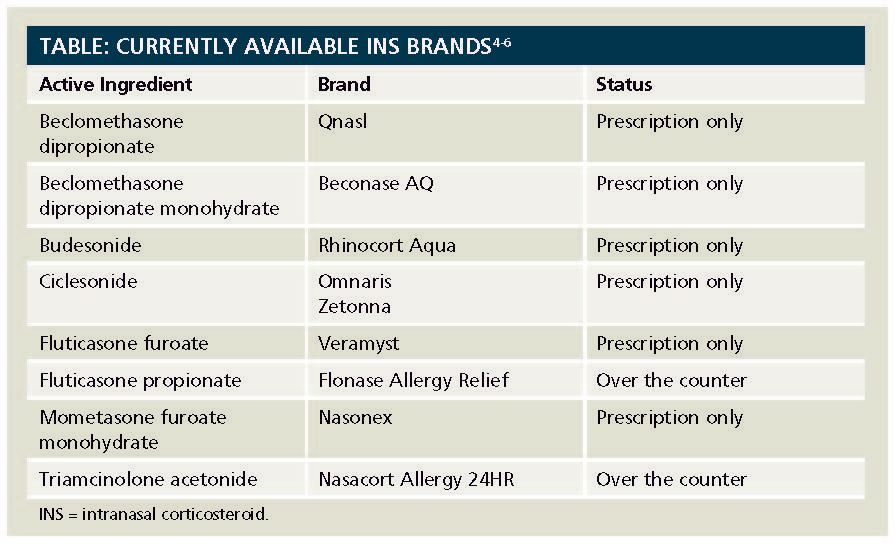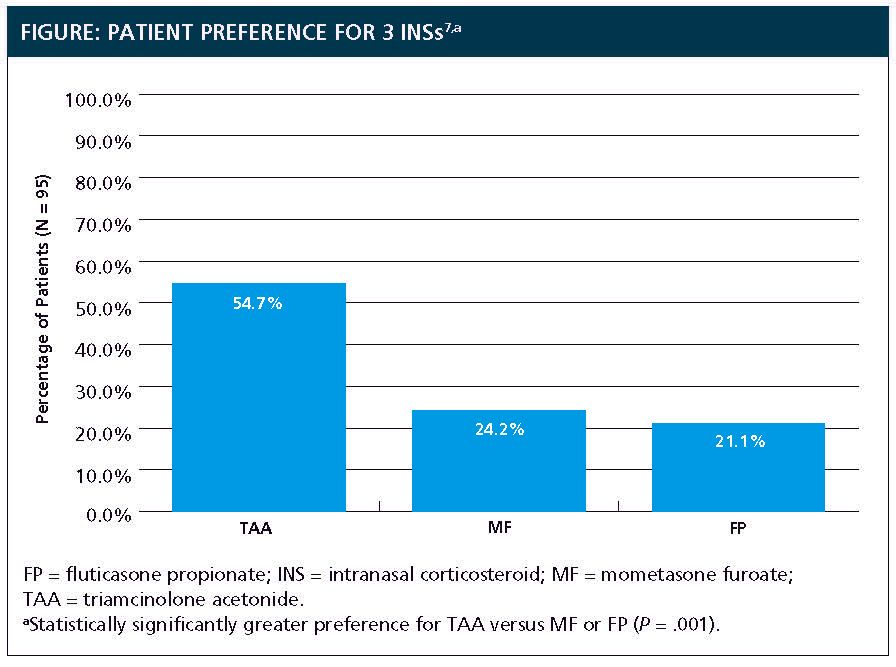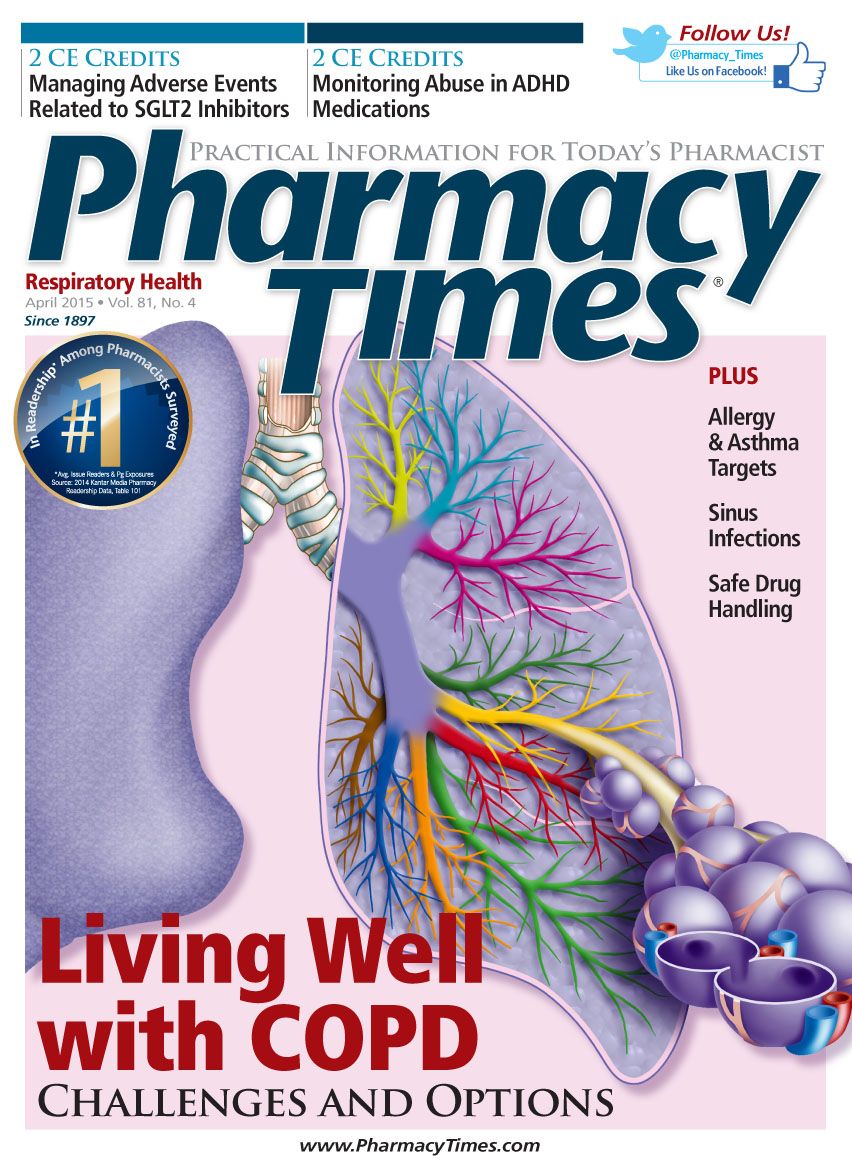Intranasal Corticosteroids: Understanding OTC Options
This article was sponsored by Chattem, Inc.
Allergic Rhinitis: Background and Treatment
Approximately 30 to 60 million people in the United States have allergic rhinitis (AR), including 10% to 30% of adults and up to 40% of children.1 Symptoms of AR may include nasal congestion, rhinorrhea, sneezing, and itchy nose. These symptoms may occur in response to indoor allergens or outdoor allergens, or both.
Intermittent AR is characterized by the presence of symptoms for fewer than 4 days in 1 week or for fewer than 4 weeks in 1 year, whereas persistent AR is characterized by the presence of symptoms for more than 4 days in 1 week and for more than 4 weeks in 1 year.1,2 Although it has often been mischaracterized as a nuisance condition, if not well controlled, AR may result in serious consequences such as poor school or work attendance, poor sleep, learning impairment, and reduced functioning in the work, social, and home settings.1
Guidelines for the management of AR published jointly by the American Academy of Allergy, Asthma & Immunology (AAAAI) and the American College of Allergy, Asthma and Immunology (ACAAI) rate intranasal corticosteroids (INSs) as the most effective class of medication for controlling nasal symptoms of AR.1 Patients taking INSs can expect an onset of therapeutic effects for nasal symptoms within 3 to 12 hours, although optimal control may take several days of use. When used appropriately at recommended doses, INSs are generally not associated with substantial systemic adverse effects (AEs)1; however, local AEs, such as nasal irritation and bleeding, may occur. The incidence of AEs may be minimized by spraying the medication away from the nasal septum.1,3
Considerations When Selecting an OTC Intranasal Steroid
Nine branded INS products are available in the United States (Table).4-6 As of this writing, 2 INSs are available over the counter: Nasacort Allergy 24HR (triamcinolone acetonide) and Flonase Allergy Relief (fluticasone propionate). The FDA approved the switches of Nasacort and Flonase from being available only by prescription to being obtainable over the counter on October 11, 2013, and on July 23, 2014, respectively.5,6

With the availability of OTC INSs, patients are now able to select an option for self-care. When considering treatment options for any condition, however, general factors to take into consideration include efficacy, safety, and product characteristics, such as formulation. With regard to INSs for the treatment of AR, the AAAAI/ACAAI guidelines note that among those currently available, clinical response does not seem to vary significantly and INSs are not generally associated with clinically significant systemic AEs.1 Thus, as the efficacy and safety profiles of INSs are similar, patient preference based on formulation characteristics of specific INSs should be taken into consideration when helping patients choose an INS product suitable for their needs.7
Formulation Characteristics and Patient Preference
In a study of preference in patients 18 years and older with a minimum 2-year history of AR, 109 patients were randomized to rate several characteristics of 3 INS regimens on a 100-point scale. These regimens included triamcinolone acetonide 220 mcg daily, fluticasone propionate 200 mcg daily, and mometasone furoate 200 mcg daily.7 (Note that the formulation of mometasone furoate was changed after this study was conducted, and the current formulation is scent-free.8)
After using the medications, participants rated the odor and taste of the triamcinolone acetonide formulation as significantly less strong than either other formulation (P ≤.001, both comparisons for odor; P ≤.001 vs mometasone furoate for taste; P ≤.05 vs fluticasone propionate for taste). In addition, a greater sensation of moisturization of the nasal mucosa was noted with the triamcinolone acetonide formulation versus either other formulation (P ≤.001 vs mometasone furoate; P ≤.01 vs fluticasone propionate). Considering these factors together, patients overall preferred the triamcinolone acetonide formulation compared with the others (Figure).7

Similar results were observed by Berger and colleagues in a study of 295 patients with a 2-year history of AR. After 3 weeks of treatment, patients reported significantly fewer odor-related complaints (12.3% vs 40.7%; P <.0001) with a triamcinolone acetonide nasal spray formulation compared with a fluticasone propionate formulation.9
As the efficacy and safety profiles of INSs are similar,1 it is important to consider patient preference and the specific characteristics of formulations when selecting an OTC INS. One formulation characteristic that may be important to patients is the presence of alcohol in the liquid vehicle. Many formulations of INSs contain alcohol, which may contribute to a feeling of dryness after administration.7 Also, the presence of alcohol in a formulation may impact its odor.10 The odor and taste associated with a particular formulation should be considered, as these attributes may be important to patient acceptance of an INS formulation.7 The liquid vehicle of OTC triamcinolone acetonide nasal spray does not include alcohol, and the formulation is free of odor and taste.7,11 The liquid vehicle of OTC fluticasone propionate contains phenylethyl alcohol.12
Role of the Pharmacist
A variety of treatment options for AR are available over the counter. The AAAAI/ACAAI guidelines for the management of AR rate INSs as the most effective class of medication for controlling nasal symptoms of AR.1 To help guide patients in selecting an OTC INS product to relieve their symptoms, it is important for pharmacists to be aware of the available OTC INS options and their formulation characteristics, as formulation differences may affect patient experiences with a product. Having this knowledge, pharmacists can engage in a discussion with individual patients to determine what is important to them in terms of formulation characteristics and provide guidance in selecting an INS. It is also important to consider product cost when helping patients select treatment.
Pharmacists can also educate patients on when and how to use OTC INSs. For instance, INSs work best when used daily and may not provide maximum relief until they have been used consistently for several days.1 In addition, pharmacists can provide instructions on priming the spray bottle and using proper spray technique.
By understanding each patient’s needs, pharmacists can help the patient select an INS formulation and use it correctly to achieve the best possible outcomes.
References
- Wallace DV, Dykewicz MS, Bernstein DI, et al; Joint Task Force on Practice; American Academy of Allergy, Asthma & Immunology; American College of Allergy, Asthma and Immunology; Joint Council of Allergy, Asthma and Immunology. The diagnosis and management of rhinitis: an updated practice parameter. J Allergy Clin Immunol. 2008;122(suppl 2):S1-S84. doi: 10.1016/j.jaci.2008.06.003.
- Bousquet J, Khaltaev N, Cruz AA, et al; World Health Organization; GA(2)LEN; AllerGen. Allergic Rhinitis and its Impact on Asthma (ARIA) 2008 update (in collaboration with the World Health Organization, GA[2]LEN and AllerGen). Allergy. 2008;63(suppl 86):8-160. doi: 10.1111/j.1398-9995.2007.01620.x.
- Benninger MS, Hadley JA, Osquthorpe JD, et al. Techniques of intranasal steroid use. Otolaryngol Head Neck Surg. 2004;130(1):5-24.
- FDA. National drug code directory. FDA website. www.accessdata.fda.gov/scripts/cder/ndc/dsp_searchresult.cfm. Updated March 12, 2015. Accessed February 1, 2015.
- FDA. Nasacort Allergy 24HR approval letter dated October 11, 2013. FDA website. www.accessdata.fda.gov/drugsatfda_docs/appletter/2013/020468Orig1s035ltr.pdf. Accessed March 11, 2014.
- FDA. Flonase Allergy Relief approval letter dated July 23, 2014. FDA website. www.accessdata.fda.gov/drugsatfda_docs/appletter/2014/205434Orig1s000ltr.pdf. Accessed March 11, 2014.
- Bachert C, El-Akkad T. Patient preferences and sensory comparisons of three intranasal corticosteroids for the treatment of allergic rhinitis. Ann Allergy Asthma Immunol. 2002;89(3):292-297.
- FDA. Center for Drug Evaluation and Research Approval Package for: Application Number NDA 20-762/S007: Nasonex Aqueous Nasal Spray 50 mcg. Rockville, MD: Food and Drug Administration; 2004. www.accessdata.fda.gov/drugsatfda_docs/nda/2004/020762_S007_NASONEX_AQUEOUS_NASAL_SPRAY.pdf. Accessed March 11, 2014.
- Berger WE, Kaiser H, Gawchik SM, et al. Triamcinolone acetonide aqueous nasal spray and fluticasone propionate are equally effective for relief of nasal symptoms in patients with seasonal allergic rhinitis. Otolaryngol Head Neck Surg. 2003;129(1):16-23.
- Mahadevia PJ, Shah S, Leibman C, Kleinman L, O'Dowd L. Patient preferences for sensory attributes of intranasal corticosteroids and willingness to adhere to prescribed therapy for allergic rhinitis: a conjoint analysis. Ann Allergy Asthma Immunol. 2004;93(4):345-350.
- Nasacort Allergy 24HR drug facts. Nasacort website. http://nasacort.com/hcp/downloads/NAS_DrugFacts_FNL-4.pdf. Accessed March 11, 2015.
- Flonase Allergy Relief drug facts. Flonase website. www.flonaseprofessional.com/content/dam/NA_Pharma/Country/US/Brands/Flonase/Digital/Web/PDFs/en_us/flute-expert-site/resources/FLONASE_Drug_Facts.pdf. Accessed March 11, 2015.

